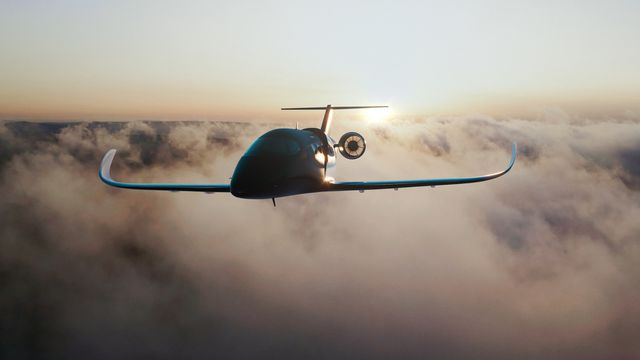Aviation companies understand the importance of reducing carbon footprint and have been working on developing cleaner fuels for several years. After Airbus and Embraer presented their projects, it’s now Beyond Aero’s turn to enter the scene.
Introduction of Beyond Aero
Hydrogen-Powered Executive Jet
The Toulouse-based startup presented its hydrogen-powered executive jet at the latest International Paris Air Show. The 85 kW scale ground tests are currently underway, and the goal is to have the jet in the air soon.
The Beyond Aero hydrogen-powered executive jet has a range of 1,500 kilometers, a maximum speed of 575 km/h, and can accommodate 4 to 8 occupants.
“Our team has designed a state-of-the-art hybrid propulsion system that seamlessly combines hydrogen tanks and batteries to power the rotating propeller. The best part? It’s already roaring. But quietly,” explains the company.
Ground Testing at 85 kW Scale and Plans for Flight
The Beyond Aero team is currently conducting ground tests on a 85 kW scale to ensure that the hydrogen-powered executive jet is safe and ready for flight. These tests are important to fine-tune the propulsion system and make any necessary adjustments before taking to the skies.
Specifications of the Hydrogen-Powered Executive Jet
The hydrogen-powered executive jet developed by Beyond Aero demonstrates impressive specifications. With a range of 1,500 kilometers and a maximum speed of 575 km/h, it is capable of transporting 4 to 8 occupants. This makes it an ideal option for executive travel, providing both comfort and eco-friendliness.
Infrastructure as a Challenge for Sustainable Aviation
Just like in the case of land vehicles, such as cars and trucks, which are also exploring the transition to hydrogen, infrastructure has been identified as one of the main challenges for a more environmentally friendly aviation industry.
Valentin Chomel, Director of Product and Strategy at Beyond Aero and one of the founders of the startup, pointed out that it is easier to create a hydrogen-powered aircraft from scratch than to transform giant airplanes into a less polluting mode of transportation. However, he raised a concern.
According to Chomel, more than the necessary precautions regarding the storage and thermal management of the hydrogen used to fuel the planes, the real concern is ensuring that there is sufficient infrastructure to meet the increased demand. And he believes that demand will increase exponentially.
Challenges of Transforming Aircraft into Greener Transportation
Transforming airplanes into a less polluting mode of transportation presents several challenges. Unlike cars, where a wide range of alternative fuel options are available, aviation requires specialized infrastructure and technology to support hydrogen-powered aircraft.
In addition to the technological aspect, there are also economic considerations. The cost of retrofitting existing aircraft with hydrogen propulsion systems may be prohibitive, especially for older planes. This poses a challenge in making the transition to a more sustainable aviation industry.
Storage and Thermal Management of Hydrogen
One of the critical aspects of using hydrogen as a fuel source for aircraft is the storage and thermal management. Hydrogen is a highly flammable gas, and ensuring safe storage and handling is of utmost importance.
Proper storage and thermal management systems need to be designed and implemented to prevent any potential risks. This includes measures such as maintaining optimal temperature and pressure conditions and implementing robust safety protocols.

Need for Sufficient Infrastructure to Meet Demand
As the demand for hydrogen-powered aircraft increases, it is crucial to have sufficient infrastructure in place to support it. This includes not only refueling stations but also production facilities for hydrogen fuel.
Investments in infrastructure are necessary to ensure a smooth transition to a more sustainable aviation industry. Without adequate infrastructure, the potential benefits of hydrogen-powered aircraft may not be fully realized.
Dilemma: Jet Demand vs. Infrastructure Investment
The aviation industry faces a dilemma when it comes to the transition to hydrogen-powered jets. On one hand, customers may be hesitant to purchase jets if there is a lack of refueling infrastructure. On the other hand, investors may be reluctant to invest in infrastructure if there is no demand for hydrogen-powered aircraft.
This “chicken or the egg” scenario poses a challenge that needs to be addressed. Collaboration between aviation companies, investors, and governments is essential to find solutions that encourage the adoption of hydrogen-powered aircraft while ensuring the necessary infrastructure is in place.
Considerations for the Future of Hydrogen-Powered Air Transportation
The development and testing of hydrogen-powered executive jets by Beyond Aero are significant steps towards a more sustainable aviation industry. However, there are still challenges to overcome, particularly regarding infrastructure and retrofitting existing aircraft.
The future of hydrogen-powered air transportation holds great promise. It offers the potential to reduce carbon emissions and create a more environmentally friendly mode of travel. With continued investment in research, development, and infrastructure, we can pave the way for a greener aviation industry.
Conclusion
As the aviation industry continues its pursuit of cleaner and more sustainable fuels, hydrogen-powered aircraft represent a promising step forward. The efforts of companies like Beyond Aero highlight the potential of this technology to reduce carbon emissions and create a more environmentally friendly mode of travel. However, addressing infrastructure challenges and ensuring a smooth transition remains critical for realizing the full benefits of hydrogen-powered aviation. Collaboration between industry stakeholders and government support will play a pivotal role in shaping the future of air transportation.












